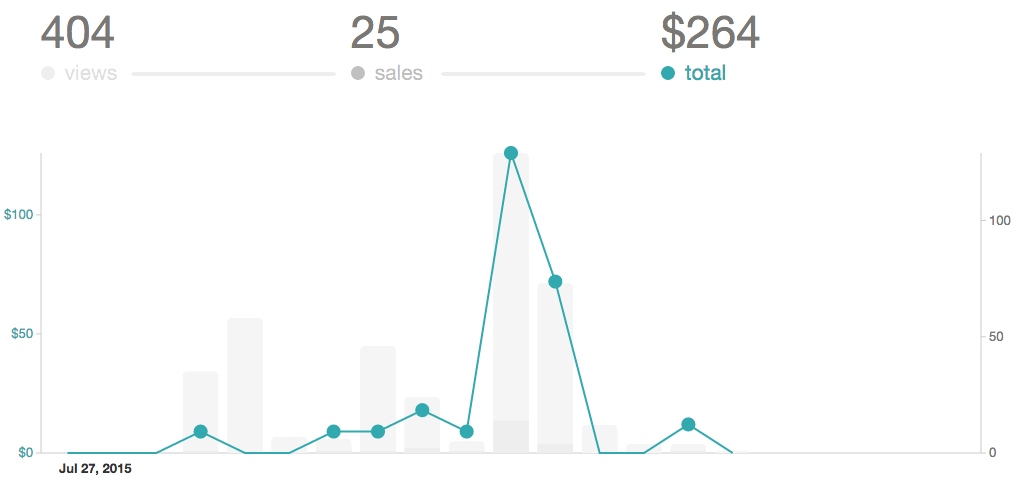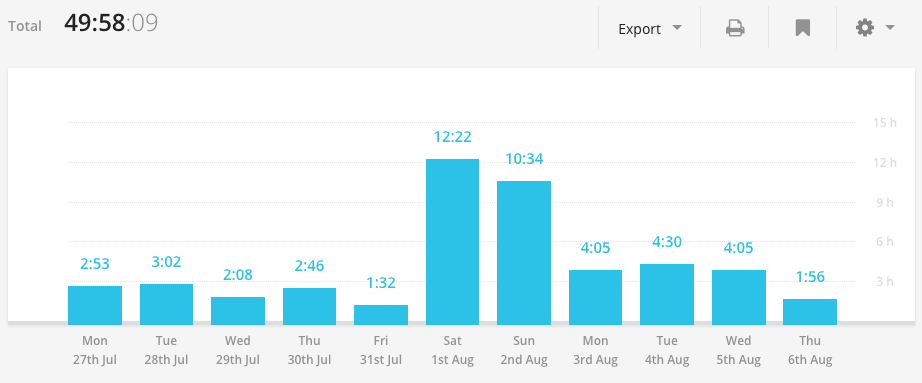Forcing yourself to write a book in 11 days via reckless public commitment
Update 2nd August 2016: I’m working on big improvement to the book now. Find out more about the book or sign up for updates at the end of this article.
This is one of those blog posts about ‘I done this thing’ that people seem compelled to write, seemingly immune to the possibility that most people are not interested in their personal journey of self-discovery or the realisation that you can do something if you, well, Just Do It hard and quickly.
Well, if you’re curious about why I decided to write a book in eleven days and you really feel you Won’t Believe What Happened Next, read on. I will try to avoid platitudinous advice about how you can emulate my grand success (or otherwise) and focus on Real Things That Actually Happened. If you’re not interested, bail now. I promise to Stop Using Title Case. I have real numbers for you too.
Around a day before it started, on the weekend of 25 July, I came across the Small Product Lab, an online course that challenges you to market, create and ship a small product in eleven days. I immediately saw this for what it is - a clever marketing ruse by Gumroad to get people to use their platform for selling your personal digital products. I got sucked in though, because they were appealing to my desire to make something of my own.
Why oh why?
This a question I asked myself over and over again when I was drowning under a mountain of research and writing tasks. You need to be pretty clear about the answer.
I wanted to take on a completely different project with a completely different feel to that of my day job, where I manage a team of front-end developers. I love my job, but we’ve been working on a single product for years. Like many people, I would have previously scratched this itch by working on some doomed side project that never sees the light of day. I’ve got enough of those in my projects folder, thank you.
Similarly, this blog has giant hole in it because I’ve not made a concerted effort to get in the habit of writing. I’ve never been the most prolific of writers, but I always found it enjoyable and rewarding in the past, and I wanted to unblock my block. Dramatically. In eleven days.
Hack days, despite their critics, can be fun, and force you to make something publicly in a very short period of time. You can make something exciting but executed roughly in the time allowed. The Small Product Lab promised a similar challenge. Can you, as an individual, go through the whole process of researching, conceiving, marketing, creating, pricing and shipping a product at very short notice? What’s more, can you sell this thing to people that are actually willing to pay for it? Welp.
I am slow and deliberate in much of my work. This can be a benefit at times, but I often feel guilty for not going faster and taking a hit on the quality of the output to get things moving. I am also a fan of the things in life that generally benefit from going more slowly, like cooking and reading. For once, I wanted to go fast to see what it feels like. I constantly struggled against tweaking, correcting and improving as I went along.
Goals
My goal for this first launch was to sell one full price copy to one complete stranger. Not a sound financial plan, but a personal milestone. That’s it.
This encompasses the real goal here - to push myself to ship something, and start that habit. Get stuff out, warts and all, and take the feedback, good or bad.
Tools
If you’re interested in the mechanics of my book authoring process, I kept it very simple. I use Markdown all the time, so it was natural to find something which takes Markdown source files and magically converts them into a book. I chose Gitbook. They provide a free Node.js-based tool as well as a hosting and selling platform.
I used Sketch for the cover design, which I did in about 10 minutes flat. No point going crazy there. I’ll improve it later.
I used Trello for planning.
I used Toggl for time tracking. You should track your time on projects like this so you can look back and shock yourself (and also get some insight on what takes time).
I used the World Wide Web for research.
Pricing
The pre-launch price of the book was $9. I originally had it much lower, by my good friend Philip Roberts persuaded me to bump the price up, based on his own assessment of the potential value. He wasn’t wrong. I had read enough about pricing to know that it should be based on value to the reader, not on what’s typical. But my stupid brain persuaded me that my own contribution wouldn’t be that valuable and ebooks are dirt cheap.
The final launch price would be $19. If the book can achieve its aim of helping people to automate some of the more boring parts of cross-browser testing, then this seems reasonable given the actual time savings. I still couldn’t believe that anyone would actually pay that amount of money though.
Numbers so far
There’s no point being coy here. I’m not trying to get rich or start a publishing empire. Here are some facts and figures as of 12 August 2015, 16 days after the start of the challenge and six days since the book launched.
- 25 copies sold, with 20 at pre-launch pricing, two at discounted launch pricing, and three at full price
- 10 copies were sold to friends, acquaintances, colleagues and arch enemies (you know who you are)
- Gross earnings of $264. Once Gumroad take their cut (5% plus 25c per transaction), that comes down to $244.55. Then there’s income tax… ho hum
- I have sold two full-price copies to complete strangers, thus doubling my launch target!
Here’s a graph of the sales timeline:

Visits are in the bars, with their y-axis on the right and sales are the teal line with a y-axis on the left of the graph.
Here is a breakdown of views, sales and conversion rate by referrer:
| Referrer | Sales | Conversion | Total |
|---|---|---|---|
| 15 | 6.6% | $151 | |
| Direct | 7 | 4.7% | $76 |
| 1 | 100.0% | $19 | |
| TinnedFruit | 1 | 20.0% | $9 |
| Gumroad | 1 | 9.1% | $9 |
I’m pretty pleased with the Twitter conversion rate there.
It’s worth comparing this against the amount of time I’ve spent on the project so far. Here is a break down of the time I spent each day:

Monday to Friday was a bit of market research, deciding the topic, planning and publicly committing to the endeavour. Saturday was mostly research and preparing the example code and tests. Sunday onwards was furious writing, with Wednesday left over for a quick edit, spell check and proofread. I also wrote a blog post, which took much longer than I expected.
Marketing
Marketing for this kind of product is completely new and alien to me, and still holds some of that icky feeling I get when the word ‘sales’ floats around. I feel bad for even tweeting vaguely promotional stuff. This is just something I need to get over, but as a result, my marketing work over the eleven days was limited mainly to Twitter, as is reflected in the sales charts above. I have around 650 followers, and the audience is already pretty targeted to the book topic, so I figured that was a simple place to get started for the pre-launch push.
I haven’t even considered how I will do other marketing work yet, like getting inbound links, setting up a landing page on my own site, more supporting blog posts and posting on relevant forums. The only other thing I did was to place a promotional footer on my blog posts, some of which still get decent traffic despite being 3 years old.
Here are some tweets I sent out about the book and their associated stats from Twitter Analytics:
| Tweet | Link clicks | Retweets |
|---|---|---|
| I’ll be launching “Automated Testing for Web Designers” in just 7 days! You can pre-order or sign-up for updates | 17 | 5 |
| Manual cross-browser responsive design testing is a PITA. I’m launching a guide to help out | 26 | 3 |
| After a furious weekend of writing, I’m getting closer to shipping Automated Testing for Web Designers. Pre-order: | 12 | 9 |
| Last chance to pre-order Automated Testing for Web Designers at over 50% off! Launching later today (bites knuckle) | 18 | 8 |
| $9 is about 10 minutes paid web design work. My new book, Automated Testing for Web Designers will save you hours. | 2 | 2 |
| Phew! Automated Testing for Web Designers is now available for download! Get $4 off with offer code ‘automate’! | 25 | 3 |
I’m not sure what the insight here is, except to make sure that your tweets are retweetable and make sense out of context from the rest of your timeline. You should also link to your products in your Twitter bio of course.
Motivation is bullshit
I enjoy writing, but I would never have completed this project in eleven days without the foolish initial step of telling people what I was doing before I even started on the serious research work, let alone the writing. It’s a cliché, but public commitment does indeed provide an impetus to your work. I hesitate to call it motivation. It’s more of a compulsion driven by future anticipation of the shame of not delivering on your public promises. It felt like a school assignment rather than a hobby project driven by ‘passion’. If you enjoyed school work of this nature, then maybe you would enjoy something like this.
There were one or two points in the course of the eleven days where I was having serious doubts about my own ability to deliver something, and the feasibility of the undertaking itself. I worked through this primarily by just pushing through it and focusing on addressing those specific issues, rather than soul searching and thinking about what my motivations are. The goal was selling a shipped product to one stranger. Shipping first, marketing second, and anything else is extra work. Pride means that what I shipped was not utterly contemptible (I hope).
What’s next?
I have spent enough time on the book that I’m now invested in it and want to improve on it, especially for the people that have already bought it. There are entire missing sections about cloud-based testing services, continuous integration, a review and comparison of testing tools and frameworks, and a much-needed full edit and a bit of restructuring. I’ll no doubt improve the typography and design as well.
In terms of marketing, I’m going to use this as a learning opportunity. I don’t expect to get good at marketing overnight, but practice works here as much as anywhere else I reckon. So, prepare for more blog posts on small, related topics, an email list signup form, and posting on other social networks, web design forums and community sites, and looking for opportunities for inbound links. If you’ve got any ideas, drop me a line at [email protected].
Sign up and get a free chapter
Use the form below to get a free chapter and find out when the final book will be available to buy!
